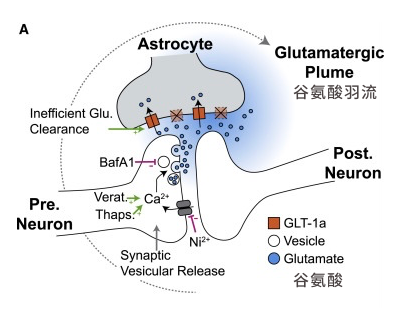When migraine, there is a "miniature tsunami" in the brain?
Author:Cool brain Time:2022.09.21


Via: Thriveglobal.com
The following is the audio of the full text of Miss Sister
Author | Neuroscience News
Translation | Zheng Jialin
Reward | Chen Yang Jian Jian Di
Grade -Cool Brain Creative
Reading | Pigeon Tsai
Artist | Old carving worm
Edit | Nutdi
The phenomenon of "glutamic acid feathers" in the brain may be the cause of signs of migraine, and feather -like glutamic acid may also be related to other brain symptoms.
Migraphy is a chronic disease that plagues many people. It is difficult to concentrate, and it brings dual torture of physical and spiritual, destroying people's normal production and life.
For the cause of migraine, there is no unified and clear theory.

Via: nytimes.com
Some people experience a threatened stage (AURA) before migraine, with visual, other perceptions, language or limb disorders in a short time.
Recently, an international study by the University of UNIVERSITY of Utah Health found that the phenomenon of "glutamic acid feathers" in the brain may be the cause of signs of migraine. And brain trauma.
01 What is "glutamic acid feathers"?
Cologne is an important exciting neurotransmitter in the brain and an indispensable substance for the normal function of the brain.
The feathers are a fluid mechanics phenomenon, such as smoke emerging from the chimney, which looks like feathers, which is a kind of feather flow.

Via: wikipedia
Let's go back to neuroscience research on migraine.
Scientists use mice as experimental animals and find that when migraine or other nervous system diseases occur, glutamic acid in the brain will be released in large quantities to space outside the cell, which will cause a "tsunami" in the brain.
Waves of electrical activities are de -polarized throughout the brain, resulting in great abnormality.
The phenomenon of abnormal release and influx of the extracellular space of this type of glutamic acid is called "glutamic acid feathers".
02 How does "glutamic acid feathers" occur?
Professor K.C. Brennan, who hosted this research, said: "The glutamic acid feathers are a new discovery of migraine mechanism, and it is likely to have a certain relationship with other nervous diseases."
Like many scientific discoveries, this discovery also happened by accident. Dr. Patrick Parker, the author of the study, was a graduate student at the Burenan laboratory at the time.
He is conducting an experiment to study whether the glutamic acid signal is abnormal in the mice that carry a certain migraine gene of humans. This human gene was found in previous research as a pathogenic gene of family hemiplegia 2 migraine (FHM2).

Via: art.els-cdn.com
As a substance that transmits signals between nerve cells, glutamic acid is important, but not as much as possible. Too many glutamic acids will excessively activate the cells and play a role in destroying. Therefore, the brain has gradually formed a method of inhibiting glutamic acid and maintaining dynamic balance during evolution.
Research previously carried out in Italy found that the FHM2 gene mutation will slow down the removal of the extracellular spacious glutamic acid, which leads to excessive activity of the brain.
However, the latest results of Parker and others are inconsistent with this conclusion. It seems that glutamic acid is released and spreads from a certain center position to form feathers.
When Parker mentioned the discovery, the previous glutamic acid research did not mention the phenomenon of glutamic acid feathers, which could not help but doubt them and wanted to explore it.

Via: neuroscience news.com
With the continuous in -depth understanding, researchers have found that these feathers are due to the disorders between the neurons in the brain and star gel cells.
Astronomical glue cells are a large number of cells in the brain except neurons. They have many functions, one of which is to control glutamic acid levels.
Therefore, the emergence of Yuliu is either because the neuron releases too much glutamic acid, or because the star gel cells absorb too few glutamic acid.
03 How does glutamic acid feathers cause brain diseases?
Research team found that feathers -like glutamic acid would cause "de -polarization". That is, when a nerve cell is excited, a large number of chemicals including glutamic acid will be released. This process will cause excitement of neurotranscene.
They are like ripples in the ponds in their brains, and they spread outward like a tsunami in the earthquake.
The occurrence of de -polarization is very common, especially in the case of stroke, alatral hypogonal hemorrhage, or brain trauma, it is also severe destructive.

Via: ANette Breindl
Parker and colleagues found that feathers -like glutamic acid can lead to de -polarization, and if the emergence of feathers can be prevented, it can inhibit exfoliating propagation.
They believe that this shows that the dissemination of Yuliu and de -polarization is not two incidents that occur at the same time. Yu Liu is likely to participate in the generation of de -polarization.
They also discovered a more important experimental evidence: not only among mice carrying the FHM2 gene, there will be a glutamic acid feathers in the phenomenon of de -polarization. Essence This means that in addition to migraine, feather -like glutamic acid may also be closely related to other brain symptoms, such as stroke. At present, the research team is further studying the role of glutamic acid feathers on migraine.
Parker said: "In the current migraine research, many evidence points to the regulation of glutamic acid in the brain, and the glutamic acid feathers we found have provided strong support for this mechanism."
In addition, another research direction is to find a method of directly testing the correlation between glutamic acid and other nervous system diseases, and at the same time hopes to provide ideas for the relevant treatment of these diseases.
references
Parker, P. D., Suryavanshi, P., Melone, M., Sawant-POKAM, P. A., Reinhart, K. M., Kaufmann, D. ... Brennan, K. C. (2020).
NON-CANONICALGLUMate Signaling in a Genetic Model of Migraine with Aura. Neuron. Https://doi.org/10.1016/j.neuron.2020.1.0.0.0


Cool brain long -term collection of brain science and psychological articles, welcome to submit
Please submit a mailbox: [email protected]
Click here, let friends know that you love brain science
- END -
Entering the countryside, entering the campus | Cultural Volunteer Runxin Tian will send beautifully to every corner

/ /▲ Township Yue Culture -Cultural Services Rural TravelThe level of ...
The party group of the Water Resources Bureau of the Waotai County held a special deployment meeting for safety production and epidemic prevention and control of projects under construction

(Li Yongqiang He Yanda) In order to strengthen the dual -defense line of the safet...